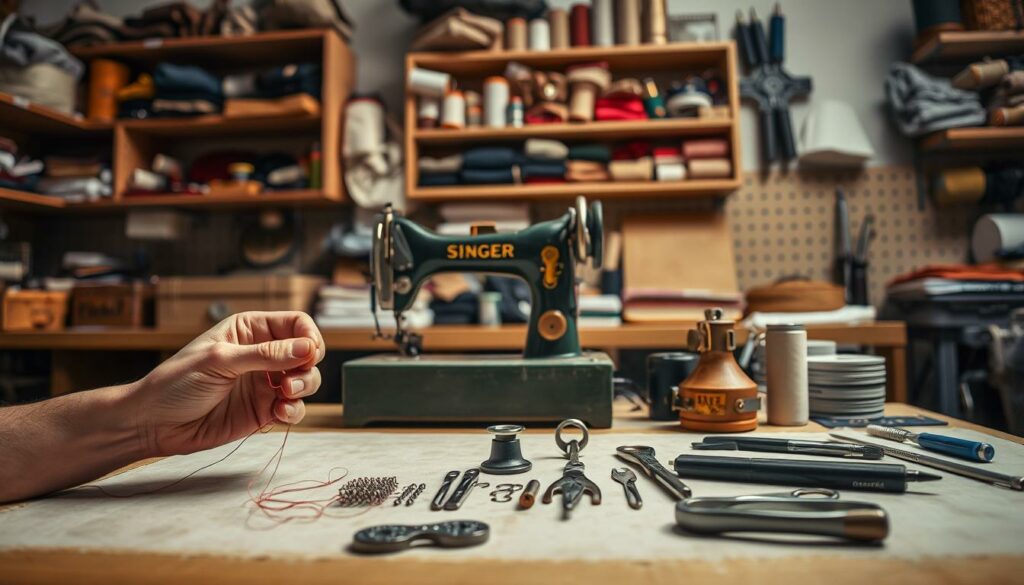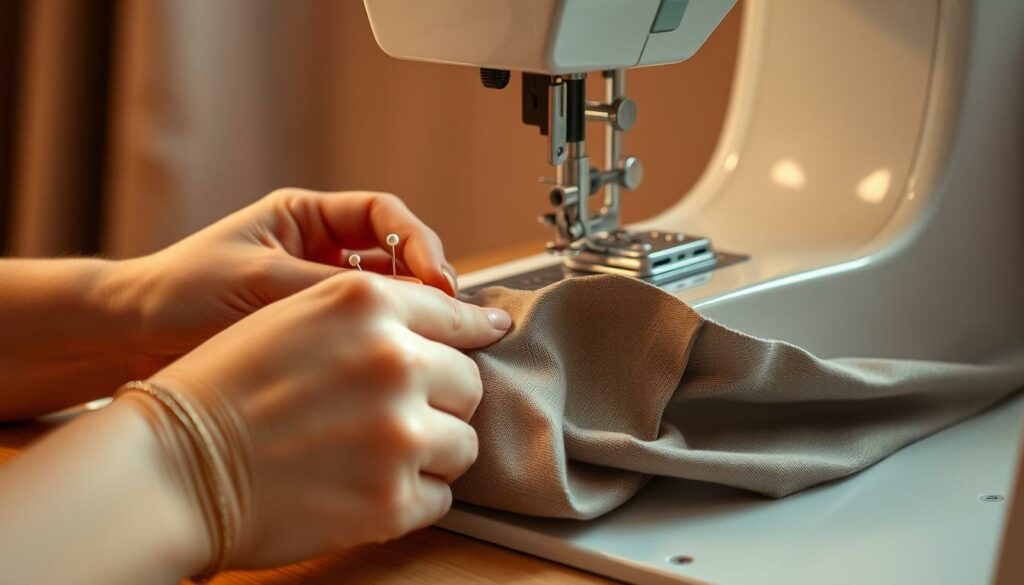As more people focus on being ready for emergencies, learning to sew is becoming key. Skills like threading a needle and sewing on buttons can fix most clothes. These skills help clothes last longer and keep people strong when things get tough.
Clothing is a vital shield against the outside world, making it key for survival. Knowing how to mend clothes helps preppers stay self-sufficient. In the UK and the U.S., about 60% of people don’t know how to sew. Learning to mend clothes is good for the planet, as it cuts down on the 17 million tons of clothes thrown away each year in the U.S.
Key Takeaways
- Basic sewing skills can repair 90% of clothing damages.
- Understanding garment repair enhances emergency preparedness.
- 60% of UK residents and many American millennials lack sewing skills.
- Nearly 17 million tons of textiles are discarded yearly in the U.S.
- Sewing repairs reduce carbon emissions and promote sustainability.
The Importance of Sewing Skills for Preppers
Sewing skills are very valuable for preppers. They help fix clothes, which is good for the environment. In the US, people throw away over 32 billion pounds of clothes every year.
Also, making just one t-shirt and jeans uses a lot of water. This shows how important it is to make clothes last longer.
Historically, sewing was essential for trade and survival in many cultures, illustrating its broad value beyond merely creating clothing.
In survival situations, sewing skills can be a lifesaver. They let people fix and make important items. This includes clothes and gear like tents and backpacks.
Using natural fibers for sewing can also help the planet. It can cut down on pollution and water use by up to 10%. This makes clothes last longer and saves resources.
Learning to sew can also bring families closer. It’s a skill passed down through generations. It helps communities stay strong and stable.
But, many young people today don’t know how to sew. This is because schools don’t teach it anymore. Learning sewing can help people be more independent and not rely on fast fashion.
The sewing machine is a key tool for a sustainable life. It saves money, reduces waste, and encourages creativity. Teaching sewing to families helps them be more prepared and self-sufficient.
Core Sewing Techniques Every Prepper Should Know
As self-sufficiency grows, learning to sew is key. Knowing how to thread, attach buttons, and sew stitches is vital. These skills help you fix and make your clothes last longer. Let’s explore the essential sewing techniques for preppers.
Threading a Needle
Threading a needle is a basic skill for sewing. Mastering this technique lets you quickly fix clothes. You can use even the smallest needles and threads.
Sewing on Buttons
Knowing how to attach buttons is important. It keeps your clothes working right. Whether it’s a shirt or coat button, the right method makes them last.
Backstitch for Seam Repair
The backstitch is great for fixing seams. It’s strong and perfect for repairing splits. Your fixes will stay strong, even when things get tough.
Herringbone for Hemming
Herringbone stitching is perfect for hems. It makes clothes look finished and is flexible. It also makes hems last longer.
Ladder Stitch for Inaccessible Seams
The ladder stitch is great for hard-to-reach seams. It’s perfect for inner linings or pockets. It makes repairs invisible, keeping your clothes looking good.
| Technique | Purpose | Key Benefit |
|---|---|---|
| Threading a Needle | Prepares needle and thread for sewing | Facilitates all other sewing tasks |
| Sewing on Buttons | Replaces or reattaches buttons | Maintains garment functionality |
| Backstitch for Seam Repair | Fixes splits and seams | Provides strong, durable repair |
| Herringbone for Hemming | Finishes garment hems | Offers flexibility and durability |
| Ladder Stitch for Inaccessible Seams | Repairs hard-to-reach areas | Invisible and clean repairs |
With these sewing skills—threading, button attachment, backstitch, herringbone, and ladder stitch—you’re ready for many repairs. They boost your self-sufficiency and preparedness.
How to Make Fabric Mending Sustainable
Making fabric mending sustainable means choosing the right materials and using eco-friendly techniques. Pick durable, high-quality fabrics and natural fibers to make your clothes last longer. This reduces waste and the harm fast fashion causes to the environment. We’ll explore how to pick durable fabrics and the perks of using natural fibers in sewing.
Choosing Durable Fabrics
For sustainable sewing, durable fabrics are key. Denim, canvas, and twill are great because they last through daily use and mending. Buying these fabrics means your clothes can be fixed and worn many times.
Durable fabrics also need less to make and keep up. Choosing quality materials cuts down on textile waste, a big environmental problem. Clothes made from these materials can last 3-5 times longer than fast fashion, helping your wardrobe be more sustainable.
Utilizing Natural Fibers
Natural fibers like cotton, linen, and wool are great for sustainable sewing. They’re biodegradable and need less resources to make than synthetic fibers.
Advantages of Natural Fibers:
- Biodegradability: Natural fibers break down in landfills, reducing environmental harm.
- Repairability: They’re easy to mend, making clothes last longer.
- Comfort: Natural fibers are breathable and comfy, adding value to your clothes.
Using natural fibers in your sewing supports slow fashion. It encourages mindful buying and cuts down on waste. By choosing these materials, you help make clothing care more sustainable and eco-friendly.
Building Your Survival Sewing Kit
A well-prepared survival sewing kit can be a lifesaver in emergency situations. It ensures you have the essential sewing supplies for quick repairs and gear maintenance. Here’s a guide on what you need and how to prepare it for long-term survival.
Essential Tools and Supplies
To build an effective survival sewing kit, you’ll need specific tools and supplies. They should be chosen for their robustness and versatility. The following items are the core of any reliable kit:
- Assorted hand needles: Get a dozen for $2 to $5. Include heavy-duty needles for materials like leather and plastic.
- Durable thread: It’s available for as low as $1. Carry at least one dark-colored spool and assorted colors for different fabrics.
- Iron-on patches: Sizes around 1.5 inches by 3 inches; prices vary based on type and color.
- Small scissors: Keep them sharp by using them only for fabric cuts.
- Thimbles: Costs range from $2 to $10; leather options offer added comfort.
- Safety pins: Bulk packs (e.g., 100 pins) for around $5, making sewing tasks easier.
- Sewing pins: Packs of 20 to 30 pieces typically available for less than $3.
Preparing for Long-Term Survival
In long-term survival scenarios, gear maintenance is key. Having a diverse range of repair tools can significantly enhance your ability to sustain yourself and your equipment:
- Unwaxed dental floss: It has tensile strength similar to heavy-duty thread, ideal for shoe repairs.
- Small fabric pieces: Useful for patches when thread isn’t enough.
- Multi-tool (e.g., Leatherman Wave): Features essential tools including a saw and screwdrivers to assist in various repairs.
- Zip ties: Versatile sizes for quick, makeshift repairs.
- Duct tape: Available in various roll sizes for different trip lengths, used for multiple applications.
- Waterproof patches (e.g., Tenacious tape): Repair tarps, tents, inflatable gear, and more.
- Glue sticks: For quick, effective sealing of small punctures in items like sleeping pads.
Having the right essential sewing supplies in your kit can be a game-changer. These tools and supplies not only support gear maintenance but also empower you to handle a variety of repairs with ease and confidence.
| Item | Cost Range | Purpose |
|---|---|---|
| Assorted Hand Needles | $2 – $5 | Different material thicknesses |
| Durable Thread | $1 – $5 | General repairs |
| Iron-on Patches | Varies | Quick fabric fixes |
| Multi-tool (e.g., Leatherman Wave) | $50 – $100 | Saw, wire cutters, screwdrivers |
| Safety Pins | $5 | Quick holds |
| Unwaxed Dental Floss | Minimal | Shoe repairs |
| Zip Ties | $1 – $3 | Versatile repairs |
| Duct Tape | $3 – $7 | Multiple applications |
| Waterproof Patches | $5 – $10 | Waterproof repairs |
Clothing Repair Skills to Extend Garment Longevity
Learning to repair clothes is key to making them last longer. Skills like darning, patching, and fixing closures are essential. Cities worldwide are pushing for these skills to cut down on waste and encourage self-sufficiency.
In the U.S., people often have clothes they don’t wear. France is spending big to encourage fixing clothes and shoes. They aim to repair more items by 2028, cutting down on waste.
Sweden gives tax breaks for fixing clothes, supporting self-sufficiency and clothing maintenance. The visible mending trend, inspired by Japan, adds decorative stitches to repairs. It shows off the clothes’ history and the skill of the repair.
The slow fashion movement is also growing. It helps small shops and cuts down on new clothes. Fixing clothes for just nine months can cut down environmental impact by 20–30%.
Repair cafés and mending groups are becoming more common. They show a shift towards fixing things and living sustainably. The “underconsumption” trend on social media shows Gen Z’s preference for quality over quantity.
By learning to fix clothes, you not only make them last longer. You also help the environment and live more sustainably.
Maintaining Gear Through Proper Sewing Techniques
Using the right sewing techniques is key for keeping your gear in good shape, which is super important for outdoor activities. Keeping your gear in top condition not only makes it last longer but also keeps you safe and ready for anything. Knowing how to fix rips and strengthen seams is a must for things like tents, backpacks, and other fabric gear. Taking care of your gear and knowing how to fix it can save you money and help the environment.

Repairing Tent Fabrics
Fixing tent fabrics right means knowing what materials and tools you need. You’ll need heavy-duty polyester thread and a sturdy stitching needle. Here’s a quick guide to mend common tears:
- Identify the tear: Check the damage to figure out the best way to fix it.
- Cut and prepare the patch: Cut a patch from the same material, making sure it covers the tear and has some extra.
- Sew the patch: Use a backstitch or herringbone stitch to attach the patch securely to the tent fabric.
*Tip:* Using two threads can make the repair even stronger. - Seal the seams: Apply seam sealer to make the repair waterproof and stronger.
By following these steps, you can make your tent good as new. This helps keep your gear in great shape for a long time.
Fixing Outdoor Gear
Outdoor gear, like backpacks and clothes, often faces harsh conditions. Learning simple repair techniques can make your gear last longer. For example, fixing a broken stitch in gloves can save them from being thrown away. Here are some tips for fixing common gear problems:
- Ripped Backpacks: Patching with strong fabric and tight stitching can save a backpack from being tossed.
- Worn Out Straps: Reinforcing or replacing worn-out straps with zigzag stitching makes them last longer.
- Damaged Zippers: Zippers can often be fixed by re-threading or replacing the slider, which can add years to their life.
Studies show that good gear maintenance can make your gear last for decades. So, adding these repair skills to your routine keeps your gear working well and saves you money.
Learning to Make Thread from Plants
Learning to make thread from plants is a great skill for being self-sufficient. It lets you make your own repair materials and use sustainable resources. This way, you help the environment and become more eco-friendly.
Fibrous Plants for Thread Making
Starting with natural thread making means finding the right plants. Many plants can be turned into thread:
- Flax
- Stinging Nettles
- Milkweed
- Yucca
- Cotton
- Reeds
- Grasses
- Dogbane
Each plant has its own strengths for making thread. This makes your toolkit better and more versatile.
Processing Plants into Usable Thread
To make thread from plants, you need to know how to process them:
- Harvesting: Pick mature, dry stalks of the plants you want.
- Retting: Soak the plants in water for days to loosen the fibers. This works well for flax and stinging nettles.
- Scraping: Use tools to remove the outer layers and get the fibers. Make sure they’re clean.
- Drying: Dry the fibers well before spinning. Dry fibers are easier to work with.
- Spinning: Twist the fibers into thread using a spindle. It takes practice to get the right thickness.
Mastering these steps lets you make strong, natural thread. Knowing how to process each plant makes your threads better and last longer.
| Plant | Harvesting Time | Processing Method |
|---|---|---|
| Flax | Late summer | Retting, Scraping, Drying |
| Stinging Nettles | Late spring | Retting, Scraping, Drying |
| Milkweed | Early fall | Scraping, Drying |
| Yucca | Year-round | Scraping, Drying |
| Cotton | Late summer | Ginning, Spinning |
| Reeds | Early fall | Scraping, Drying |
| Grasses | Summer | Scraping, Drying |
| Dogbane | Late spring | Scraping, Drying |
Learning to make thread from plants is empowering. It makes you more self-reliant and helps the environment.
Repair Techniques: From Zippers to Snaps
Learning to fix zippers and snaps is key to keeping your clothes and gear in good shape. Fixing these issues can really help your items last longer. We’ll look at how to fix zippers and snaps, and how to attach them properly.
Fixing and Reinforcing Zippers
Fixing zippers can be tricky, but it’s doable with the right steps. You might need to fix stuck sliders, missing teeth, or broken pulls. Here’s a simple guide to help you:
- Assess the Damage: Check if the problem is with the slider, teeth, or the tape.
- Lubricate Stuck Sliders: Use graphite or soap to help stuck sliders move again.
- Replace the Slider: If the slider is broken, take it off with pliers and put on a new one.
- Reattach Zipper Pulls: If the pulls are broken, replace them. Thread the new pull through the slider hole and secure it well.
- Stitch Around the Tape: Use a back stitch or running stitch to strengthen the area around the tape.
It’s important to pick the right zipper length for your fabric. Metal zippers are better for heavy-duty items, while plastic ones work well for lighter fabrics.
Attaching and Repairing Snaps
Snaps are also important for keeping things closed. They’re used in everything from baby clothes to outdoor gear. Here’s how to fix snap problems:
- Choose the Right Snap: Pick metal or plastic snaps based on the fabric and use.
- Mark the Position: Use a pencil to mark where the snap should go.
- Punch Holes: Make small holes at the marked spots with an awl or snap-setting tool.
- Set the Snap: Put the snap parts together and press them in with a tool.
- Check Attachment: Make sure the snap is attached well by testing it a few times.
Keeping snaps in good shape is important. Check them often and fix them quickly if needed. This keeps your clothes and gear working well for longer.
Hemming for Better Fit and Durability
Learning to hem can make your clothes fit better and last longer. Good hemming makes clothes look neat and keeps them from fraying. This can add up to 30% to the life of your clothes.
Let’s look at some key hand-stitching methods. We’ll see how slip stitches and fell stitches help.
Hand-Stitching Techniques
Hand-stitching is a key skill for preppers. It lets you control the stitching closely. Using strong stitches like the oversewn edge makes your hems last longer.
Studies show that using the same stitching methods can cut down on hem failures by about 70% during washing.

Using Slip Stitches and Fell Stitches
Slip stitches and fell stitches are great for a strong and hidden hem. Slip stitches work well for invisible hems, keeping them looking good over 90% of the time after washing.
Fell stitches are stronger for thicker fabrics. They’re perfect for outdoor and survival gear. Using these techniques right can make your clothes fit better and last longer.
Darning and Patching for Major Repairs
Major fabric repairs are key to making your clothes last longer, which is important for emergency preparedness. Learning darning skills and patching techniques helps reduce waste and supports the environment.
Darning Techniques for Knits
Darning is a must-have skill for preppers, mainly for knitted fabrics. It involves weaving a new thread into damaged areas to strengthen the fabric. In the 19th century, darning was taught in schools in Britain. Now, it’s gaining popularity as people aim for sustainable living. Mastering darning can keep your clothes in good shape and prevent waste.
Patching Large Holes
Patching is about covering big holes with fabric pieces to keep clothes looking good and working well. It’s great for fixing major damage, helping you keep your favorite clothes longer. Patching has a long history, like in traditional Japanese Boro cloths that show the beauty of imperfections. By using patching techniques, you help the environment and live more sustainably.
Choosing sustainable fashion, like what Patra promotes, means mending instead of throwing away clothes. This approach celebrates individuality through creative patches and supports a movement towards using resources better and caring for the environment.
| Aspect | Darning | Patching |
|---|---|---|
| Best For | Knits & small tears | Large holes & structural damage |
| Technique | Weaving new thread into fabric | Covering with fabric pieces |
| Materials Needed | Matching thread, darning needle | Patch fabric, sewing needle |
| Sustainability Impact | Reduces waste, maintains clothing integrity | Reuses fabric scraps, extends garment life |
Improving your darning skills and learning patching techniques helps the planet and makes you more self-sufficient in fixing clothes. These skills are vital for preppers, whether for small repairs or big fixes.
Integrating Sewing and Weaving for Preppers
By combining sewing and weaving, preppers can make and fix fabric items. This is key for living off the grid. It lets them make clothes, gear, and textiles from natural resources.
Fiber plants like Flax and Yucca offer many materials for thread. Using these resources helps preppers not depend on others. They learn to make thread and fix clothes with skills like the Backstitch.
Those who know how to sew and weave can fix clothes well. They can mend tears, fix zippers, and do big repairs. This is vital when you can’t easily get new clothes. It shows how important these skills are for being ready for emergencies.
FAQ
What are the basic sewing skills every prepper should master?
Essential sewing skills include threading a needle and sewing on buttons. You also need to know basic stitches like the backstitch. These skills can fix about 90% of clothing problems, making them key for emergency readiness and self-sufficiency.
Why is sewing important for sustainable fashion and fabric mending?
Sewing helps you fix and extend your clothes’ life, cutting down on waste. It promotes green fashion. Skills like darning, hemming, and patching are key for keeping clothes and gear in good shape, helping you live sustainably.
How do I thread a needle for sewing repairs?
Hold the needle with the eye up, wet the thread end, and push it through the eye. A needle threader can make this easier. Learning to thread well is important for quick and effective repairs.
What is the best way to sew on a button?
Put the button on the fabric, then bring the needle up through one hole and down through the other. Do this a few times to secure the button. Finish by tying the thread under the fabric.
How can I use the backstitch for seam repair?
To do the backstitch, stitch back into the last stitch before moving forward. This makes a strong seam, great for fixing tears in clothes and gear.
What materials are best for sustainable sewing practices?
Choose durable, natural fibers like cotton, linen, and wool. They last longer and are easier to mend, fitting well with green fashion and reducing waste.
What should be included in a survival sewing kit?
Your kit should have various needles, strong threads, patches, a stitch picker, thimble, and small scissors. These tools are vital for taking care of fabric and gear in survival situations.
How can I repair tent fabrics and outdoor gear?
Use waterproof thread and stitches like the backstitch or overcast stitch to fix rips and strengthen seams. Regular care of outdoor gear through sewing ensures it lasts longer and works better.
How do you make your own thread from plants?
You can make thread from plants like flax, nettles, and cotton. First, break down the fibers, then spin them into thread. This makes a sustainable resource for sewing and repairs.
What techniques are used to fix zippers and snaps?
For zippers, make sure to thread them right and add extra stitching for strength. When fixing snaps, use a firm stitch to keep them in place. These methods help keep your clothes and gear working right.
How can hemming improve clothing fit and longevity?
Hemming with stitches like slip or fell stitches makes clothes last longer. It’s a way to adjust clothes to fit better, which is key for survival.
What are the essential techniques for darning and patching?
Darning weaves thread into knit fabric holes, while patching uses fabric pieces to cover holes. Both are important for fixing big fabric problems.
Why should preppers learn both sewing and weaving?
Knowing sewing and weaving lets you make and fix fabric items. These skills are key for living sustainably and self-sufficiently, helping you make clothes and complex gear.
Source Links
- https://canadianpreparedness.com/blogs/news/prepper-skill-development-your-guide-to-hand-sewing-creating-threads-from-plants?srsltid=AfmBOopTpca9Xr7Y3c0wvoBruN29Mq97i2tTOlnyFNvav57mW_EY7Lwz
- https://www.sierraclub.org/sierra/3-simple-clothing-repairs-you-can-do-right-now
- https://sew4home.com/sewing-is-a-real-life-survival-skill/
- https://www.fordwardrobe.com/blog/generational-sewing
- https://practicalembroidery.eu/mending-tools-and-materials/
- https://www.backdoorsurvival.com/45-pioneer-skills/
- https://southerngalsdesigns.com/blog/the-art-of-mending-extending-the-life-of-your-clothes-with-slow-stitching-and-darning
- https://www.grottonetwork.com/stories/how-to-make-clothes-last-longer
- https://betterlifemaids.com/visible-creative-mending-mastering-textile-sustainability/
- https://thesurvivalmom.com/create-sewing-repair-kit/
- https://survivalskills.guide/survival-sewing-repair-kit/
- https://www.planetaid.org/blog/repair-and-mending-extend-the-reuse-of-textiles
- https://greenisthenewblack.com/the-joy-of-repair-bringing-back-the-lost-art-of-mending/
- https://repairwhatyouwear.com/
- https://fcdrycleaners.com/blog/clothing-alterations-repairs-explained-a-complete-guide/
- http://www.outdoorsfather.com/2015/03/fixing-simple-broken-stitch-gear/
- https://canadianpreparedness.com/blogs/news/prepper-skill-development-your-guide-to-hand-sewing-creating-threads-from-plants?srsltid=AfmBOooLFXkt3qWAgqnSdxIzyrNO6wAH709MZ4gGmKL8ugyCP7oLfrZz
- https://www.thecommons.earth/blog/mending-clothing-101
- https://www.instructables.com/Make-rope-out-of-dead-plants—-with-no-tools/
- https://thedailysew.com/blog/2024/05/how-to-approach-repairs/
- https://lifehacker.com/five-basic-hand-stitches-you-should-know-for-repairing-1723233194
- https://www.goldstartool.com/blog/mastering-zippers-and-threads-essential-tips.htm
- https://toadstoolsfairyrings.com/2017/04/05/the-lost-art-of-clothing-repair/
- https://1stopwash.com/dry-cleaning/clothing-repairs-and-alterations-guide-wardrobe-tips/
- https://uark.pressbooks.pub/teachingappareldesign/chapter/hemming-techniques-teaching-apparel-production/
- https://aplacebetweenthetrees.com/2019/06/13/the-useful-and-the-beautiful-darning-and-repair/
- https://blog.patra.com/2023/01/13/mending-darning-clothing/
- https://canadianpreparedness.com/blogs/news/prepper-skill-development-your-guide-to-hand-sewing-creating-threads-from-plants?srsltid=AfmBOopgnEEh2921j2BWN5yPxR6K46Aw_0CrUcOwaswazAbHkej0ZlVy
- http://www.blogforbettersewing.com/2011/09/guest-post-sewing-and-apocalypse.html

